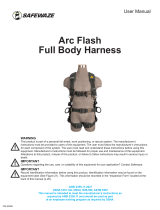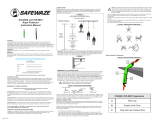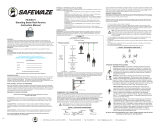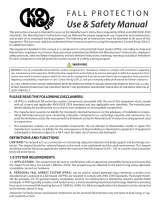
Lanyard
Instruction Manual
ANSI Z359.1 - 2007
This manual is intended to meet the manufacturer’s instructions
as required by ANSI Z359.1 - 2007 and should be used as part of an
employee training program as required by OSHA.
WARNING
This product is part of a personal fall arrest, work positioning, or rescue system. The manufacturer’s instructions must be provided to users of this
equipment. The user must follow the manufacturer’s instructions for each component of the system. The user must read and understand these instructions
before using this equipment. Manufacturer’s instructions must be followed for proper use and maintenance of this equipment. Alterations to this product,
misuse of this product, or failure to follow instructions may result in serious injury or death.
IMPORTANT
Questions regarding the use, care, or suitability of this equipment for your application? Contact Safewaze.
IMPORTANT
Record identication information before using this product. Identication information may be found on the equipment label (see page 11). This information
should be recorded in the “Inspection Log” located at the back of this manual (p 10).
Do not throw away these instructions!
Read and understand these instructions before using equipment!
User Information
Date of First Use:
Serial#:
Trainer:
User:
INTRODUCTION
Thank you for purchasing an Safewaze fall protection lanyard. This manual must be read and understood in its
entirety, and used as part of an employee training program as required by OSHA or any applicable state agency.
This manual and any other instructional material must be available to the user of the equipment. The user must
understand how to safely and eectively use their full body harness, and all fall
protection equipment used in conjuction with the full body harness.
APPLICABLE SAFETY STANDARDS
When used according to instructions, lanyards included in this manual meet all applicable ANSI Z359.1 standards and
OSHA regulations for fall protection. Applicable standards and regulations depend on the type of work being done, and
may include state-specic regulations. Refer to local, state, and federal (OSHA) requirements for additional information
concerning the governing of occupational safety regarding Personal Fall Arrest Systems (PFAS).
WORKER CLASSIFICATIONS
Understand the denitions of those who work in proximity of or may be
exposed to fall hazards.
Qualied Person: “Qualied” means one who, by possession of a recognized degree, certicate, or professional
standing, or who by extensive knowledge, training, and experience, has successfully demonstrated his ability to solve
or resolve problems relating to the subject matter, the work, or the project.
Competent Person: “Competent person” means one who is capable of identifying existing and predictable hazards
in the surroundings or working conditions which are unsanitary, hazardous, or dangerous to employees, and who has
authorization to take prompt corrective measures to eliminate them.
Authorized Person: “Authorized person” means a person approved or assigned by the employer to perform a
specic type of duty or duties or to be at a specic location or locations at the job site.
It is the responsibility of a Qualied or Competent person to supervise the job site and
ensure safety regulations are complied with.
PRODUCT SPECIFIC APPLICATIONS
Purpose: The Safewaze series of lanyards are designed to be used as part of a Personal Fall Arrest System (PFAS).
- A competent person shall train users on this equipment in accordance with OSHA and ANSI.
- Never exceed a free fall distance of 6 ft. A free fall of more than 6 ft could cause excessive
arrest forces that could result in serious injury or death.
- All Safewaze lanyards have a maximum capacity of 310 lbs including any tools, clothing,
accessories, etc..., unless otherwise rated by Safewaze. NOTE: Safewaze HW lanyards
are rated to 400 lb maximum capacity.
- Anchorages for attachment of Safewaze lanyards shall support a minimum of
5,000 lbs or be designed with a safety factor of two by a Qualied Person.
- All Safewaze lanyards must IMMEDIATELY be removed from service if subjected to fall arrest
forces.
- Safewaze lanyards shall be inspected by the end user prior to each usage and
by a Competent Person other than the user at least annually. These annual inspections shall
be documented.
Lanyard Length
(6’ Total)
Deceleration
distance (3.5’ total)
Height of harness dorsal
D-ring from
worker’s feet
(6’ total)
Safety factor
(2’ total)
Required
distance
from
Anchorage
(17.5’ total)
Fall Clearance: There must be sucient clearance below the anchorage connector to arrest a fall before the user
strikes the ground or an obstruction. When calculating fall clearance, account for a MINIMUM 2’ safety factor,
deceleration distance, user height, length of lanyard/SRL, and all other applicable factors. (See Figure 1)
LIMITATIONS
Fall Clearance Diagram
***Diagram shown is an example
fall clearance calculation ONLY.
For all applications: worker weight capacity range
(including all clothing, tools, and equipment) is 130-310 lbs
FIGURE 1
Swing Falls: Prior to installation or use, make considerations for eliminating or minimizing all swing fall hazards.
Swing falls occur when the anchor is not directly above the location where a fall occurs. Always work as close to in
line with the anchor point as possible. Swing falls signicantly increase the likelihood of serious injury or death in the
even of a fall. (See Figure 2)
A
FALL-ARREST
S
W
I
N
G
F
A
L
L
COMPATIBILITY OF CONNECTORS
Connectors are compatible with connecting elements when they have been designed to work together in such a
way that their sizes and shapes do not cause their gate mechanisms to inadvertently open regardless of how they
become oriented. Connectors (hooks, carabiners, and D-rings) must be capable of supporting at least 5,000 lbs.
(22.2 kN). Connectors must be compatible with the anchorage or other system components (see Figure 4). Do not
use equipment that is not compatible. Non-compatible connectors may unintentionally disengage (see Figure 3).
Connectors must be compatible in size, shape, and strength. Self-locking snap hooks and carabiners are required by
ANSI Z359 and OSHA guidelines. Contact Safewaze if you have any questions about compatibility.
FIGURE 3 - UNINTENTIONAL DISENGAGEMENT
Non-compliant part
3 - gate opens
2 - gate presses
against
non-compliant
part
4 - and parts
disengage.
1 -
NOTE: SOME SPECIALITY CONNECTORS HAVE ADDITIONAL
REQUIREMENTS. CONTACT SAFEWAZE WITH QUESTIONS.
FIGURE 2
FIGURE 4 - INAPPROPRIATE CONNECTIONS
MAKING CONNECTIONS
Snap hooks and carabiners used with this equipment must be double locking and/or twist lock. Ensure all connections
are compatible in size, shape and strength. Do not use equipment that is not compatible. Ensure all connectors are
fully closed and locked.
Safewaze connectors (snap hooks and carabiners) are designed to be used only as specied in each product’s user’s
instructions. See gure 4 for examples of inappropriate connections. Do not connect snap hooks and carabiners:
• To a D-ring to which another connector is attached.
• In a manner that would result in a load on the gate (with the exception of tie back hooks). NOTE: Large snap hooks
must not be connected to objects which will result in a load on the gate if the hook twists or rotates. Snap hooks
marked with ANSI Z359.1-2007 or ANSI Z359.12 and are equipped with a 3,600 lb (16 kN) gate. Check the marking
on your snap hook to verify its compatibility.
NOTE: Large throat snap hooks must not be connected to standard size D-rings or similar objects
which will result in a load on the gate if the hook or D-ring twists or rotates, unless the snap hook
complies with ANSI Z359.1-2007 or ANSI Z359.12 and is equipped with a 3,600 lb (16 kN) gate. Check
the marking on your snap hook to verify that it is appropriate for your application.
• In a false engagement, where features that protrude from the snap hook or carabiner catch on the anchor, and
without visual conrmation seems to be fully engaged to the anchor point.
• To each other.
• By wrapping the web lifeline around an anchor and securing to lifeline except as allowed for Tie Back models (see
section 4.5).
• To any object which is shaped or sized in a way that the snap hook or carabiner will not close and lock, or that
roll-out could occur.
• In a manner that does not allow the connector to align properly while under load.
CONNECTION
Energy Absorbing Lanyards: Energy absorbing lanyards must be connected with the energy absorbing end of the
lanyard connected to the Dorsal D-ring of the full body harness. The opposing end of the lanyard is to be connected
to the anchorage connector.
Tie-Back Energy Absorbing Lanyards: Place the Tie-Back Energy Absorbing Lanyard over the qualied anchor, then
open the gate of the Tie-Back hook and pass the lanyard through the hook. The lanyard may make more than one
wrap around the anchor, but the lanyard may only be passed through the Tie-Back hook once. Pull lanyard hand tight
around the anchor and attach the energy absorbing end of the lanyard to the dorsal D-ring of the harness.
Dual Leg Lanyards: Dual Leg Lanyards are designed for single person use only and must be connected with the
energy absorbing end of the lanyard connected to the Dorsal D-ring of the full body harness. Do not connect the
energy absorbing end of the lanyard to any anchorage connector. Attach one end of the Dual Leg Lanyard to the
anchorage connector and the unused lanyard leg to an approved lanyard storage keeper on the full body harness.
Warning: Never attach the unused leg of the back to the harness at any location other than a lanyard
storage keeper.
Soft Loop Energy Absorbing Lanyards: Place the soft loop of the Energy Absorbing Lanyard through the Dorsal
D-ring of the full body harness, then pass the snap hook of the Energy Absorbing Lanyard through the soft loop an pull
entire Energy Absorbing Lanyard through until tight on the D-ring.
Personal Energy Absorbers: Personal Energy Absorbers should be connected to the Dorsal D-ring of the full body
harness rst, then connected to the rest of the fall arrest system.
Connecting Personal Energy Absorbers and Energy Absorbing Lanyards to Fall Arresters: Personal Energy
Absorbers or Energy Absorbing Lanyards less than 3 feet in length, and less than 2 feet in length for CSA, may be
attached to a Fall Arrester. Energy Absorbing Lanyards must be connected with the energy absorbing end of the
lanyard connected to the Dorsal D-ring of the full body harness. Personal Energy Absorbers must be connected to
the Dorsal D-ring of the full body harness rst, then connected to the Fall Arrester. Fall Arresters with permanently
attached personal energy absorbers should be connected directly to the Dorsal D-ring of the full body harness.
Using a connector that is undersized or irregular in shape (1) to connect a snap hook or carabiner could allow the
connector to force open the gate of the snap hook or carabiner. When force is applied, the gate of the hook or carabiner
presses against the non-compliant part (2) and forces open the gate (3). This allows the snap hook or carabiner to
disengage (4) from the connection point.
PERFORMANCE
6 Foot Free Fall: Personal Energy Absorbers and Energy Absorbing Lanyards marked to ANSI Z359.13-09 and rated
for a 6 foot free fall, have an average arrest force of 900 lbf (4 kN) or less, and a maximum deployment distance of 48
inches (1067 mm) when dynamically tested in accordance with the requirements of the ANSI Z359.13-09 standard.
12 Foot Free Fall: Personal Energy Absorbers and Energy Absorbing Lanyards marked to ANSI Z359.13-09 and rated
for a 12 foot free fall, have an average arrest force of 1,350 lbf (6 kN) or less and a maximum deployment distance of
60 inches (1524 mm) when dynamically tested in accordance with the requirements of the ANSI Z359.13-09 standard.
ANSI Z359.1-07: Personal Energy Absorbers and Energy Absorbing Lanyards marked ANSI Z359.1-07 have a
maximum arrest force of 900 lbf (4 kN) or less, and a maximum deployment distance of 42 inches (1067 mm) when
dynamically tested in accordance with the requirements of the ANSI Z359.1-07 standard.
MANUAL-LAN

SPECIFIC LANYARD APPLICATIONS
WARNING
• Users should consult with their doctor to verify ability to safely absorb the forces of a fall
arrest event. Fitness level, age, and other health conditions can greatly aect an
individuals ability to withstand fall arrest forces. Women who are pregnant, individuals
considered minors must not use any Safewaze equipment.
• Never alter any part of a lanyard or add/remove components. Safewaze shall not be held
responsible for injury or death due to tampering.
• Lanyards that are exposed to fall arrest forces MUST be IMMEDIATELY removed from
service and destroyed.
• Failure to follow these instructions and warnings could result in serious injury or death in
the event of a fall.
• A preplanned rescue procedure in the event of a fall is required. The rescue plan must be
specic to the project. The rescue plan must allow for employees to rescue themselves, or
to be promptly rescued by alternative means.
• Harnesses or connectors selected for use with any Safewaze lanyard must compatible in
size and conguration. User must ensure compatibility of snap hooks, carabiners and other
connectors. Any connection which could allow disengagement must be eliminated. Snap
hooks and carabiners must be self locking and self closing and must never be hooked to
each other.
• A Competent Person must conduct an analysis of the workplace and anticipate where workers
will be conducting their duties, the route they will take to reach their work, and the existing
and potential fall hazards they may be exposed to. The Competent Person must choose the
fall protection equipment to be utilized.
• Do not misuse equipment.
• Equipment designated for fall protection must never be used to lift, hang, support or hoist
tools or equipment unless specically certied for such use.
IF ANY OF THESE CONDITIONS EXIST
LANYARD MUST BE REMOVED FROM SERVICE
• Safewaze Lanyards shall be inspected prior to each use by the user and at least annually
by a Competent Person. Annual inspections shall be documented. Severity of conditions during
use may neccesitate increased frequency of documented inspections.
• Lanyards that fail inspection MUST be removed from service and destroyed immediately.
• All components of the Lanyards shall be inspected. Hardware inspection will include all
Snap Hooks, D-rings, Web, Adjusters, and Rope or Cable (if applicable).
• Snap Hooks, D-rings, and Adjusters should have smooth surfaces with no indication of corrosion
or damage that could negatively impact harness webbing.
Lanyard Webbing, Snap Hooks, D-rings, adjusters, and other components must be inspected for:
1. Excessive Wear 8. Mold or Mildew
2. Cuts 9. Broken Stitches
3. Abrasions 10. Alterations and Additions
4. Undue Stretching 11. Rust, Oxidation, or Corrosion
5. Chemical Exposure 12. Legibility of Labeling
6. Burns or Excessive Heat 13. Deformation
7. Welding Spatter 14. Discoloration or Abraded Appearance
INSPECTION
MAINTENANCE & STORAGE
WARRANTY
Safewaze Lanyards can be cleaned with water and mild soap and hung to air dry. Do not use chemical cleaners, harsh
detergents, or solvents. Do not dry harness with heat.
Hardware can be wiped o with a clean, dry cloth.
Safewaze Lanyards should be stored in a cool, dry, and clean environment. Do not store in direct sunlight or where
chemical vapors could come in contact with the harness.
Safewaze warrants its products are free from defects in materials and construction under normal use and service.
Liability is not accepted for abuse, modication, improper use, destructive activity and contaminated exposure.
Personal Fall Arrest: External Shock Lanyards and Internal Shock Lanyards, are the only
Safewaze lanyards approved for Personal Fall Arrest applications as part of a Personal Fall Arrest
System (PFAS). The structure to which lanyard is attached must withstand loads applied in the
directions permitted by the system of at least 5,000 lbs. Maximum allowable free fall is 6’. For Fall
Arrest applications, the only allowable attachment point to harness for Safewaze shock lanyards is
the Dorsal D-ring.
Restraint: External Shock, Internal Shock, and Positioning Lanyards are authorized for use
in Restraint applications. User must always account for fully deployed length of shock absorbing
lanyards if utilized for restraint. The structure to which the lanyard is attached must withstand loads
applied in the directions permitted by the system of at least 1,000 lbs NO free fall is permitted.
Restraint systems may only be used on surfaces with slopes up to 4 / 12 (vertical / horizontal). For
Restraint applications, the allowable attachment points to harness are Dorsal D-ring, Chest D-ring,
Side D-rings, and Shoulder D-rings.
Work Positioning: External Shock and Positioning Lanyards are authorized for use in Work
Positioning applications. Work Positioning allows a worker to be supported during suspension while
freeing both hands to conduct work operations. The structure to which lanyard is attached must
withstand loads applied in the directions permitted by the system of at least 3,000 lbs. Maximum
allowable free fall is 2’. For positioning applications, the allowable attachment points to harness are
the Side D-rings.
Rescue/Conned Space: External Shock and Positioning Lanyards are authorized for use in
Rescue/Conned Space applications. Rescue systems are utilized to safely recover a worker from
a conned location or after exposure to a fall. Composition of rescue systems can vary based upon
the type of rescue involved. The structure to which a lanyard is attached must withstand loads
applied in the directions permitted by the system of at least 3,000 lbs. NO free fall is permitted. For
rescue applications, the allowable attachment points to harness are Dorsal D-ring, Chest D-ring and
Shoulder D-rings.
INSPECTION LOG
Date Inspection Items
Noted
Corrective Action Initials
LABELS
Safewaze
225 Wilshire Ave SW
Concord, NC 28025
PHONE: 800-230-0319
FAX: 704-262-9051
EMAIL: [email protected]
Web: safewaze.com
External Shock Lanyard
Example
Personal Energy
Absorber Example
Internal Shock Lanyard
Example
Positioning Lanyard
Example
All above referenced applications have a worker weight capacity range of
310 lbs (including all clothing, tools, and equipment).
www.safewaze.com
www.safewaze.com
www.safewaze.com
www.safewaze.com
225 Wilshire Ave SW
Concord, NC 28025
P: (800) 230-0319
F: (704) 262-9051
225 Wilshire Ave SW
Concord, NC 28025
P: (800) 230-0319
F: (704) 262-9051
225 Wilshire Ave SW
Concord, NC 28025
P: (800) 230-0319
F: (704) 262-9051
225 Wilshire Ave SW
Concord, NC 28025
P: (800) 230-0319
F: (704) 262-9051
/










